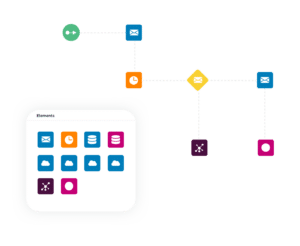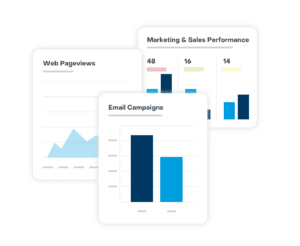The 3 Most Important Stages of Every Marketing Funnel
Think about the last item you bought. Whether it was a pack of gum or a car, you made multiple decisions to reach the point of purchase. While consumers and B2B buyers have different needs, the buyer journey is largely similar. It takes customer research and a series of decisions to go from cold prospect to ready-to-buy. We call this the marketing funnel.
What is a Marketing Funnel?
The marketing funnel is a customer’s journey from a new lead to a converted customer with your brand. It is sometimes called a conversion funnel or inbound funnel.
It’s called a funnel because the shape represents how marketers gather leads and usher them through the buyer journey. The process begins with a wide opening to let many prospective buyers in. It then flows deeper into the funnel, converting leads into customers and shaping them into loyal fans.
There are several different funnel types, each with its own set of funnel stages. You should choose the one that makes the most sense for the length and stages of your typical buyer journey.
Basic Funnel
In general, all funnel models are based on this basic format. Awareness includes advertising and promotional activities, consideration encompasses information gathering and education, and conversion represents a final decision or sale.
- Awareness
- Consideration
- Conversion
Marketing Funnel
Marketers are interested in a customer’s journey from lead to customer to full-blown brand advocate.
- Awareness | Top of Funnel (TOFU)
- Consideration & Conversion (marketing-qualified lead) | Middle of Funnel (MOFU)
- Activation & Loyalty & Advocacy | Bottom of Funnel (BOFU)
Sales Funnel
Sales focus on taking leads across the finish line to conversion. They prefer warm MQLs that will flow easily down the funnel.
- Marketing-qualified lead (MQL)
- Sales-qualified lead (SQL)
- Sales meeting
- Sales proposal
- Close
Another way to identify the sales funnel stages is from prospect/visitor → lead → MQL → SQL → opportunity → customer.
AIDA
Brands use the AIDA model to plan their messages and qualify leads as they complete each stage of the funnel.
- Attention — “What do you do?”
- Interest — “I’m listening…”
- Desire — “I’m interested.”
- Action — “I’m in.”
Reaching Prospects at Each Stage of the Funnel
Tailoring your messages for each funnel stage with the appropriate content in the most relevant channels is essential. For instance, social media and search are great channels for reaching broad audiences with far-reaching messages. As you collect prospects’ information, you can email them directly or create nurturing campaigns that will resonate with their industry, company size, or solution needs. Long-form content and phone calls are appropriate for deep education and personalized discussions as they move farther down the funnel.
Gather metrics across each channel to better understand how potential customers end up at each funnel stage. Web pages are especially helpful at gauging interest with metrics like:
- Number of page visits
- Session duration
- Page conversion rate
- Clicks on page
Gather what works and what doesn’t. It’s important to measure high-traffic pages and drop-off pages where viewers often leave quickly. Collect metrics like:
- Conversion rate
- Conversion rate by channel
- Drop-off rate
- Cost per acquisition
- MQLs
- MQLs to customers rate
Best Practices for Each Stage of the Funnel
Though every brand’s marketing and sales funnel is different, you can better understand how to create content and reach more people with a deeper look at the basic funnel foundations.
- Awareness
What channels do you use to attract attention? Which ones work best? Track channel performance to better understand which audiences react best to your messages. Then, create content that mirrors new prospects thinking with broad messages about what you do. Tailor ads and blog topics to new prospects’ questions about your industry or solution (e.g., What is legal case management?).
Don’t know how customers found you? Ask with surveys or include a “How did you find us?” field in your initial prospect form.
- Consideration
Prospects are like sponges at this stage. They want to learn more—but do you have enough high quality web content to satisfy them? Share education in multiple ways, from FAQs and long-form blogs to guides, webinars, and videos. Provide content that will proactively answer their biggest questions so they can move faster and further down the funnel.
- Conversion
Once leads reach the bottom of the funnel, bring them across the finish line with helpful, convenient experiences. Remove barriers to conversion. Make it easy for them to contact you. List your features and pricing on your website. Send emails with targeted language to encourage conversion. Make your hard sell!
Many funnel models end after conversion, but modern customers want more. They expect the same level of attention and enthusiasm you showed in the early stages of trying to get their business, but nurturing customers “beyond the funnel” benefits your brand.
When you continue engaging with customers after the purchase, you build loyal fans who do your advertising for you. Move new customers to a different, ongoing nurture track that keeps them in the loop, treats them like exclusive members, and encourages upselling. Work with the customer or technical teams to ensure smooth and helpful onboarding. Then, regularly engage with customers and ask for feedback to learn how you can improve the entire buyer journey.
Move Faster Down the Funnel with SugarCRM
Sugar Market is the all-in-one marketing platform that helps you move prospects from unengaged leads to loyal brand advocates faster. Sugar’s tools can help you support sales in the conversion process:
- Attract more prospects and understand which digital assets led them to your funnel.
- Qualify leads with multi-step nurture campaigns and sophisticated lead scoring models that quantify exactly how engaged prospects are.
- Snag the strongest leads with conversion-focused email content, landing pages, and forms.
You can also automate repetitive tasks and build stronger connections with sales by automatically handing off qualified leads. Sugar Market helps you target and nurture prospective customers at every funnel stage with features like dynamically optimized marketing content, multi-channel marketing abilities, and powerful analytics to quantify performance.
Stop getting stuck in the funnel. See how Sugar Market shortens the buyer journey by watching a demo today.



